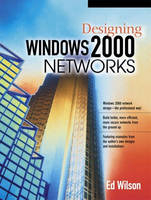
Designing Windows 2000 Networks
Prentice Hall (Verlag)
978-0-13-066199-9 (ISBN)
- Titel ist leider vergriffen;
keine Neuauflage - Artikel merken
Windows 2000 promises unprecedented power and flexibility -- but only if IT professionals design their networks to take full advantage of its capabilities. In this comprehensive, hands-on guide, leading Microsoft technology consultant Ed Wilson shows how. Wilson presents high-level overviews of every major consideration in Windows 2000 network design, then drills down to the technical details -- providing specific guidance for planning, prototyping, and deployment. Designing Windows 2000 Networks covers the Windows 2000 deployment process from start to finish. Ed Wilson offers proven advice for assembling teams, planning migration, minimizing risk, avoiding pitfalls associated with structuring domains, working with native and mixed mode, providing appropriate infrastructure, prototyping, fine-tuning, and debugging performance. Coverage includes: designing for Active Directory, DNS, and WINS; unattended installations; troubleshooting, and much more. Wilson uses extensive illustrations and network diagrams, and walks through detailed scenarios for large enterprises, mid-sized companies, and small businesses.
For every IT professional who has implemented or is planning to implement a Windows 2000-based network.
ED WILSON is a senior networking specialist with Full Service Networking, a Microsoft Solution Provider Partner in Cincinnati, Ohio. One of the nation's leading authorities on deploying Windows 2000 networks, Wilson's roster of clients includes a variety of both Fortune 500 and Fortune 100 companies. He is the author of An Administrator's Guide to Windows 2000 TCP/IP Networks and Network Monitoring and Analysis: A Protocol Approach to Troubleshooting, both for Prentice Hall PTR, and has contributed to several other networking books. He holds several key certifications, including MCSE Internet, MCT, CCNA, and Master ASE.
Foreword.
Preface.
I. PRELIMINARY CONSIDERATIONS.
1. A Quick Overview.
First Things First. What are the Expectations? The Business Case. Understand Your Environment. Architect for Success. Focus on Technology Integration. Chapter Review. In the Next Chapter.
II. Migration Strategies.
2. Planning a Migration.
Relationship of Namespace. DNS Planning Considerations. AD Sizing. Domain Design Considerations. Evaluating Existing Network Infrastructure. Evaluating Existing Servers. Evaluating Existing Desktops. Chapter Review. In the Next Chapter.
3. Selecting a Migration Strategy.
Developing a Migration Strategy. Choosing between Upgrade Paths. Evaluate the Order for the Migration. Migration Process. Upgrade Considerations. Why Go Native? Chapter Review. In the Next Chapter.
4. Group Policy Planning.
Group Policy Backgrounder. Deployment Planning Scenarios. Chapter Review. In the Next Chapter.
5. Lowering Desktop TCO.
Scenarios for Lowering Desktop TCO. Change and Configuration Management. Managing Change. Group Policy Considerations. Scope of Management. Group Policy Best Practice. Chapter Review. In the Next Chapter.
III. Implementing Migration Strategies.
6. Sample Windows 2000 Migration.
Technical Requirements. The Impact of AD. Desktop Support Issues. Design the Directory Service Architecture. Chapter Review. In the Next Chapter.
IV. UNDERSTANDING THE COMPONENTS.
7. Dynamic Host Configuration Protocol.
DHCP Backgrounder. DHCP Building Blocks. New Features in Windows 2000 DHCP. Installing the DHCP Server Service. Creating DHCP Multicast Scopes. Managing and Monitoring DHCP. Troubleshooting a DHCP Server. Chapter Review. In the Next Chapter.
8. Windows Internet Naming System.
Understanding WINS. Installing WINS. Configuring WINS. Troubleshooting WINS. Chapter Review. In the Next Chapter.
9. Windows 2000 DNS.
A Look at the Namespace. DNS Concepts. Implementation Details. Chapter Review. In the Next Chapter.
10. Active Directory.
Managing AD Operations. Chapter Review. In the Next Chapter.
11. Interoperability and Migration.
Consider the Possibilities. Exchange 2000 Integration. Chapter Review. In the Next Chapter.
V. Troubleshooting.
12. Troubleshooting.
Troubleshooting AD. Troubleshooting Group Policy. Chapter Review.
Appendix A: Well-Known TCP and UDP Port Numbers.
Appendix B: Command Line Utilities.
Appendix C: Troubleshooting Common Network Errors.
Runt / Long Frames. CRC or FCS Errors. Collisions. Late Collisions.
Appendix D: NetBIOS Suffixes.
Appendix E: Group Policy Result.
Glossary.
Index.
| Erscheint lt. Verlag | 6.12.2001 |
|---|---|
| Verlagsort | Upper Saddle River |
| Sprache | englisch |
| Maße | 176 x 234 mm |
| Gewicht | 971 g |
| Themenwelt | Informatik ► Betriebssysteme / Server ► Windows |
| Informatik ► Betriebssysteme / Server ► Windows Server | |
| Mathematik / Informatik ► Informatik ► Netzwerke | |
| ISBN-10 | 0-13-066199-6 / 0130661996 |
| ISBN-13 | 978-0-13-066199-9 / 9780130661999 |
| Zustand | Neuware |
| Haben Sie eine Frage zum Produkt? |
aus dem Bereich


